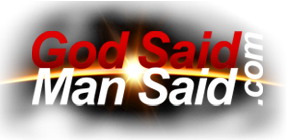The Day Jesus Died
Darkness? The rent veil? The earthquake? The annals of time declare it, and this article represents just the tip of the information that would be found by diligent search. The Wrd of God is true and righteous altogether. Believe it, and it will be a lamp unto your feet.| Audio Options: | MP3 |
The Day Jesus Died
No one gains access to God by carnal academic investigation, for God and truth can only be spiritually discerned. The Word of God must be approached on your hands and knees with Godly fear. Jesus said in Matthew 18:2-3:
2 And Jesus called a little child unto him, and set him in the midst of them,
3 And said, Verily I say unto you, Except ye be converted, and become as little children, ye shall not enter into the kingdom of heaven.
All sons and daughters of Adam must come to the place where they consider their options, and either make a decision for Christ or against Him. At this point, those who choose Jesus repent of their sins and forsake them, and surrender their entire being to the Lord of Glory and His holy Word. This is called being born of the spirit—born-again—and this is the only doorway to God and His truth. This childlike surrender is the doorway to eternal life. If you have not yet chosen Christ, why not now? Click on to "Further With Jesus" for instant entry into the Kingdom of God. NOW FOR TODAY’S SUBJECT.
GOD SAID, Matthew 27:45-54:
45 Now from the sixth hour there was darkness over all the land unto the ninth hour.
46 And about the ninth hour Jesus cried with a loud voice, saying, Eli, Eli, lama sabachthani? that is to say, My God, my God, why hast thou forsaken me?
47 Some of them that stood there, when they heard that, said, This man calleth for Elias.
48 And straightway one of them ran, and took a sponge, and filled it with vinegar, and put it on a reed, and gave him to drink.
49 The rest said, Let be, let us see whether Elias will come to save him.
50 Jesus, when he had cried again with a loud voice, yielded up the ghost.
51 And, behold, the veil of the temple was rent in twain from the top to the bottom; and the earth did quake, and the rocks rent;
52 And the graves were opened; and many bodies of the saints which slept arose,
53 And came out of the graves after his resurrection, and went into the holy city, and appeared unto many.
54 Now when the centurion, and they that were with him, watching Jesus, saw the earthquake, and those things that were done, they feared greatly, saying, Truly this was the Son of God.
MAN SAID: There never was a Jesus Christ, nor a crucifixion, or resurrection, but merely a man-made concoction of religious beliefs by which to control the ignorant.
Now THE RECORD. Did the amazing events that the Word of God declares in the book of Matthew actually occur? Does history record the bizarre three-hour darkness that prevailed from noon to 3:00 p.m., or the veil of the temple that was rent from top to bottom, or the earthquake, all scripturally recorded as happening at the time of Christ’s crucifixion? The answer is yes!
Concerning the three hours of darkness that God’s Word refers to, secular historians such as Thallus and Phlegon attribute this darkness to a solar eclipse, but erroneously—which will be pointed out later; however, Phlegon’s statement is particularly telling. It reads:
There was the largest and most famous eclipse that had ever occurred. The day was so turned into night at the sixth hour (noon), that the stars were seen. Also, an earthquake in Bithynia destroyed many houses in the city of Nicaea. [End of quote]
Three hours of darkness? The following excerpt is found on this website in the feature article, "The Historicity of Jesus Christ:"
One of the first Gentile writers who mentions Christ is Thallus, who wrote in 52 AD. However, his writings have disappeared and we only know of them from fragments cited by other writers. One such writer is Julius Africanus, a Christian writer who lived about 221 AD. What he has to say is that Thallus, in the third book of histories, explains away a certain darkness as an eclipse of the sun. This is unreasonable, of course, because a solar eclipse could not take place at the time of the full moon and it was the time of the Paschal full moon that Christ died. From this reference, we see that the gospel account of the darkness which fell upon the land during Christ’s crucifixion was well known, and required a naturalistic explanation from those non-believers who witnessed it. So Thallus was attributing it to an eclipse of the sun, but it couldn’t have been an eclipse of the sun since it was the Paschal full moon. You see, Jesus Christ was crucified on the Passover—the Paschal full moon. [End of quote]
Henry Morris, in his book Many Infallible Proofs, writes this on the subject of this miraculous darkness:
There is no evidence in astronomical history of a normal solar eclipse at this time, though there are certain traditions in other lands of a period of darkness. Yet the fact of this supernatural darkness was apparently well known to all those that dwelt in Jerusalem, and to those who read first the accounts of it in the Gospels.
The Annals of the World, a book written by Archbishop Ussher, was published two years after his death in 1658 AD. According to paragraph 6501, he refers to the writings of Eusebius who wrote in the fourth century:
Eusebius also mentioned Lucian. Lucian, the martyr, testified in Rufinus to the darkness at that time by appealing to the writings of the heathen themselves:
Search your writings and you shall find that, in Pilate’s time, when Christ suffered, the sun was suddenly withdrawn and a darkness followed.
Before him, Tertullian had stated:
At the same moment, the day was withdrawn even when the sun was at the height. Those who never knew that this also had been spoken concerning Christ, judged it to be nothing but an eclipse. However, you shall find this event, that happened to the world, recorded even in your own archives. [End of quote]
In the temple of the Lord, there was a particularly special veil that separated the Jewish people from the Most Holy Place. The high priest was only permitted to enter this place once a year to bring a blood sacrifice for the sins of the children of Israel. This veil was rent from the top to the bottom as Jesus Christ gave up the ghost on Golgotha’s hill. The rending of the veil represents the doing away with the Old Testament shadows and types of Christ and the ushering in of the Kingdom of God which is indwelling in all who are born-again—all who are followers of Christ. Hebrews 10:19-20:
19 Having therefore, brethren, boldness to enter into the holiest by the blood of Jesus,
20 By a new and living way, which he hath consecrated for us, through the veil, that is to say, his flesh;
Concerning this holy veil, Alfred Edersheim, author of the 1,109-page tome, The Life and Times of Jesus the Messiah, weighs in with the following:
And now a shudder ran through Nature, as its Sun had set. We dare not do more than follow the rapid outlines of the Evangelic narrative. As the first token, it records the rending of the Temple-Veil in two from the top downward to the bottom; as the second, the quaking of the earth, the rending of the rocks and the opening of the graves. Although most writers have regarded this as indicating the strictly chronological succession, there is nothing in the text to bind us to such a conclusion. Thus, while the rending of the Veil is recorded first, as being the most significant token to Israel, it may have been connected with the earthquake, although this alone might scarcely account for the tearing of so heavy a Veil from the top to the bottom. Even the latter circumstance has its significance. That some great catastrophe, betokening the impending destruction of the Temple, had occurred in the Sanctuary about this very time, is confirmed by not less than four mutually independent testimonies: those of Tacitus (Hist. v. 13), of Josephus (War 6.5.3), of the Talmud (Jer. Yoma 43c; Yoma 39b), and of earliest Christian tradition. The most important of these are, of course, the Talmud and Josephus. The latter speaks of the mysterious extinction of the middle and chief light in the Golden Candlestick, forty years before the destruction of the Temple; and both he and the Talmud refer to a supernatural opening by themselves of the great temple-gates that had been previously closed, which was regarded as a portent of the coming destruction of the Temple. We can scarcely doubt, that some historical fact must underlie so peculiar and widespread a tradition, and we cannot help feeling that it may be a distorted version of the occurrence of the rending of the Temple-Veil (or of its report) at the Crucifixion of Christ.
But even if the rending of the Temple-Veil had commenced with the earthquake, and, according to the Gospel to the Hebrews, with the breaking of the great lintel over the entrance, it could not be wholly accounted for in this manner. According to Jewish tradition, there were, indeed, two Veils before the entrance to the Most Holy Place (Yoma 5.1). The Talmud explains this on the ground that it was not known, whether in the former Temple the Veil had hung inside or outside the entrance and whether the partition-wall had stood in the Holy or Most Holy Place (Yoma 51b). Hence (according to Maimonides) there was not any wall between the Holy and Most Holy Place, but the space of one cubit, assigned to it in the former Temple, was left unoccupied, and one Veil hung on the side of the Holy, the other on that of the Most Holy Place. According to an account dating from Temple-times, there were altogether thirteen Veils used in various parts of the Temple — two new ones being made every year. The Veils before the Most Holy Place were 40 cubits (60 feet) long, and 20 (30 feet) wide, of the thickness of the palm of the hand, and wrought in 72 squares, which were joined together; and these Veils were so heavy, that, in the exaggerated language of the time, it needed 300 priests to manipulate each. If the Veil was at all such as is described in the Talmud, it could not have been rent in twain by a mere earthquake of the fall of the lintel, although its composition in squares fastened together might explain, how the rent might be as described in the Gospel.
Indeed, everything seems to indicate that, although the earthquake might furnish the physical basis, the rent of the Temple-Veil was—in reverence be it said—really made by the Hand of God. [End of quote]
Jerome, a man renowned in the early church, who lived between 340 and 420 AD, wrote in a letter to Hedibia that the huge lintel of the Temple, which was over 30 feet long weighing some 30 tons (60,000 lbs.), was splintered and broken and fallen. He connects this to the rending of the veil. Edersheim writes: "...and it would seem an obvious inference to connect again this breaking of the lintel with an earthquake." The Old Testament Amos prophesies of this event in Amos 9:1:
I saw the Lord standing upon the altar: and he said, Smite the lintel of the door, that the posts may shake: and cut them in the head, all of them; and I will slay the last of them with the sword: he that fleeth of them shall not flee away, and he that escapeth of them shall not be delivered.
The earthquake that took place at the time of our Lord’s crucifixion was also referred to in Dr. Morris’ book quoted earlier. It reads:
Another miracle, of course, is the earthquake. In fact, there was an earthquake both at the time of the crucifixion and again at the time of the resurrection. Earthquakes are natural phenomena, so that the miraculous aspect of these quakes was in their peculiar timing. That they were significantly violent quakes is proved by the statement of Matthew: ". . . the earth did quake and the rocks rent" (Matthew 27:51).
Darkness? The rent veil? The earthquake? The annals of time declare it, and this article represents just the tip of the information that would be found by diligent search. The Word of God is true and righteous altogether. Believe it, and it will be a lamp unto your feet.
GOD SAID, Matthew 27:45-54:
45 Now from the sixth hour there was darkness over all the land unto the ninth hour.
46 And about the ninth hour Jesus cried with a loud voice, saying, Eli, Eli, lama sabachthani? that is to say, My God, my God, why hast thou forsaken me?
47 Some of them that stood there, when they heard that, said, This man calleth for Elias.
48 And straightway one of them ran, and took a sponge, and filled it with vinegar, and put it on a reed, and gave him to drink.
49 The rest said, Let be, let us see whether Elias will come to save him.
50 Jesus, when he had cried again with a loud voice, yielded up the ghost.
51 And, behold, the veil of the temple was rent in twain from the top to the bottom; and the earth did quake, and the rocks rent;
52 And the graves were opened; and many bodies of the saints which slept arose,
53 And came out of the graves after his resurrection, and went into the holy city, and appeared unto many.
54 Now when the centurion, and they that were with him, watching Jesus, saw the earthquake, and those things that were done, they feared greatly, saying, Truly this was the Son of God.
MAN SAID: There never was a Jesus Christ, nor a crucifixion, or resurrection, but merely a man-made concoction of religious beliefs by which to control the ignorant.
Now you have THE RECORD.
References:
Authorized King James Bible
Edersheim, A., The Life and Times of Jesus the Messiah, Hendrickson Publishers, pp893- 894
Morris, H., Many Infallible Proofs, Master Books, p82
Ussher, J., The Annals of the World, Master Books, p822
Additional Audios
- Further with Jesus
- Geologists Say Yes To Crucifixion
- The Day Jesus Died
- True & Righteous Altogether (The Historicity of Jesus Christ)
- The Historicity of Jesus Christ Updated
- Da Vinci Code
- Jesus and His Brother James
- Great Drops of Blood
- The Empty Tomb
- The Christ of Calvary: Was He?
- Prelude to Historicity
Power Verse
Acts 1:8 (KJV)
But ye shall receive power, after that the Holy Ghost is come upon you: and ye shall be witnesses unto me both in Jerusalem, and in all Judea, and in Samaria, and unto the uttermost parts of the earth.







